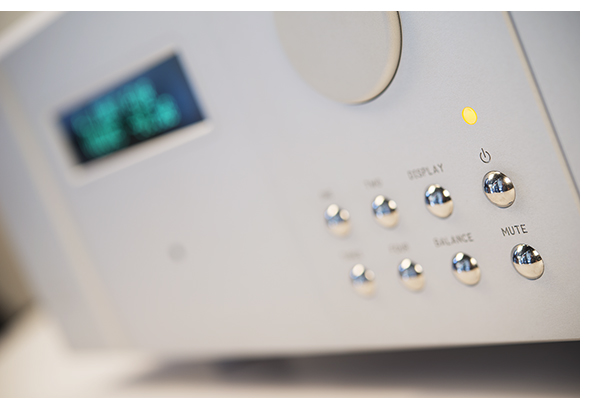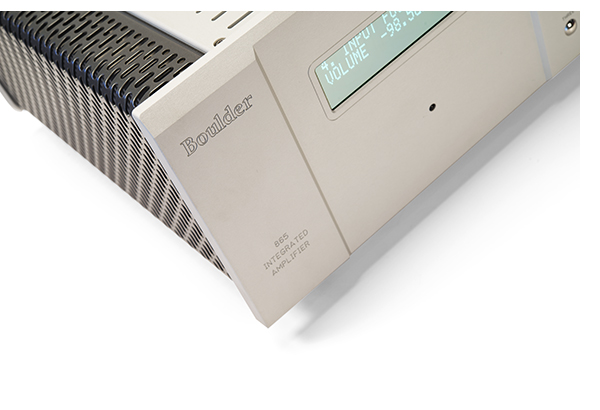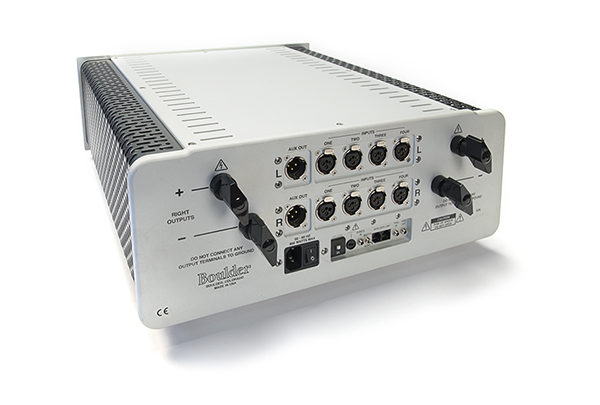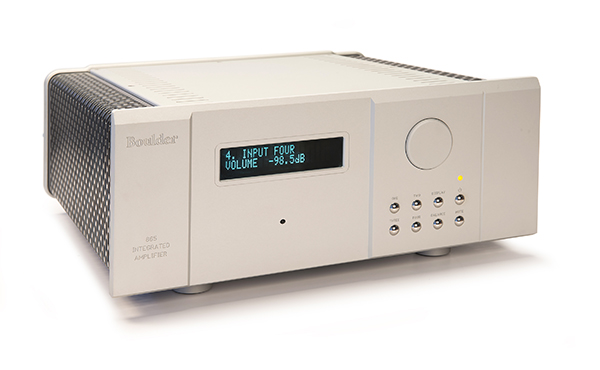 Following Steve Martin’s vocal musings on “Late For School,” it becomes immediately apparent how well this integrated amplifier, Boulder’s entry-level piece, keeps track of pace and timing.
Following Steve Martin’s vocal musings on “Late For School,” it becomes immediately apparent how well this integrated amplifier, Boulder’s entry-level piece, keeps track of pace and timing.
Martin’s voice meanders around the soundstage thrown between my KEF Blades, with banjos, bass and percussion all firmly anchored in place, with a hint of animal sounds for good measure. Though this is the most affordable piece in the Boulder lineup, “entry level” doesn’t do it any more justice than calling a Cayman an “entry level” Porsche.
The 865 is truly a product only a company like Boulder can build, taking advantage of their design, build and production facilities – one of the very few North American companies that performs every speck of construction in house. Their completely vertical process allows them the luxury to use much higher quality everything than you might expect in a $13,000 integrated, right down to one of their cool, machined remote controls. Every detail is attended to perfection as it is in their $200,000 3050 monoblocks. Should your audio journey take you no further than the 865, this is an amplifier you’ll be proud to hand down to one of your family members. It lacks nothing in terms of sound or build quality in comparison to the Boulder flagship products.
 The XRCD version of Jackie McLean’s Swing, Swang, Swingin’ proves equally illuminating. Like every other Boulder product I’ve experienced, the 865 follows the family tradition by neither adding nor subtracting to the sound. While this may bring slightly less to the presentation on poor quality recordings, that can benefit from a bit of warmth, what it does for stellar recordings is well worth the tradeoff. Just like the 3050 monoblocks that we reviewed last year, the 865 is a wonderful conduit for music, never throwing the focus on itself; it’s always in the service of the music.
The XRCD version of Jackie McLean’s Swing, Swang, Swingin’ proves equally illuminating. Like every other Boulder product I’ve experienced, the 865 follows the family tradition by neither adding nor subtracting to the sound. While this may bring slightly less to the presentation on poor quality recordings, that can benefit from a bit of warmth, what it does for stellar recordings is well worth the tradeoff. Just like the 3050 monoblocks that we reviewed last year, the 865 is a wonderful conduit for music, never throwing the focus on itself; it’s always in the service of the music.
Even my worst recordings come to life when the 865 is part of the system. Records lacking in tonal and dynamic range (like KISS Alive! or Then And Now…The Best of the Monkees) reveal layers of detail that never comes to life on a lesser amplifier, not to mention the tremendous dynamic slam on tap – the same experience I had with the 3050s.
Utilizing the same stepped volume control from the 800 series preamplifier, originally developed for the 2010 preamplifier, the 865 maintains perfect (within .5db) channel balance throughout the range, and all of the buttons and controls retaining the same feel you’ve come to expect in the top of their range. Even though the case work has been streamlined a bit, the feel is still there in spades.
 All Boulder
All Boulder
If you’re wondering what you don’t get for the $13k pricetag, and why this amplifier is so compact compared to the larger Boulder models – the answer is simple. Boulder founder Jeff Nelson likes to talk about watts being relative and that the bigger amplifiers, with their bigger power supplies are more about control than what their wattage ratings suggest.
Where the larger Boulder amplifiers are full class-A designs, the 865 is biased in class A mode for the first 17 watts per channel, then it gently transitions into class AB mode to its full power rating of 150 watts per channel. But make no mistake, the 865 gives up precious little in ultimate fidelity and control. Boulder has done a brilliant job of incorporating the maximum amount their essence into this compact, by comparison product. The 865 is the heart of the 810 preamplifier and 860 power amplifier (which is half of the 1000 series amplifier) squeezed into a single chassis weighing just under 50 pounds.
The drum solo in Little Feat’s Day or Night, is rendered superbly, with plenty of attack, decay and texture. If there is anything that I could characterize as the Boulder sound (or lack of it) is the way their amplifiers have an effortless transient response, and present a more realistic rendition of drums and percussion than any other amplifier I’ve experienced – and the 865 is no slouch.
As with every Boulder amplifier, the 865 uses a fully balanced topography, so those with single ended ancilliary components will need to use adaptors to interface. Though Boulder feels that balanced is the ultimate way to experience their components, we did have excellent luck with the single ended components at our disposal, mainly the Zesto and CJ phono preamplifiers in for review. The 865 does not feature an integrated phonostage, so vinyl lovers will either have to choose one of theirs, and I highly suggest the awesome 1008 phonostage, or go to a third party.
Top notch throughout
While most listening was done via an analog front end consisting of the ARC REF Phono 2SE phonostage (balanced), AVID Acutus Reference SP turntable, SME V tonearm and Clearaudio Goldfinger v.2 cartridge, along with the dCS Vivaldi performing digital duties, the 865 was never the weak link in the chain, holding its own in the context of a six figure reference system.
 Switching between the KEF Blades, the Dynaudio Evidence Platinum speakers and the GamuT S9, the 865 did its job-playing music effortlessly. Moving it to room two with the Dynaudio Confidence C1s and the Sonus faber Guareri Evolution speakers, both extremely high performance, yet small speakers made an incredible case for stopping the audio journey right here and just enjoying the music. The 865 reveals so much that if you don’t need to blow the windows out of your listening room and you just want to revel in quality – this is your amplifier.
Switching between the KEF Blades, the Dynaudio Evidence Platinum speakers and the GamuT S9, the 865 did its job-playing music effortlessly. Moving it to room two with the Dynaudio Confidence C1s and the Sonus faber Guareri Evolution speakers, both extremely high performance, yet small speakers made an incredible case for stopping the audio journey right here and just enjoying the music. The 865 reveals so much that if you don’t need to blow the windows out of your listening room and you just want to revel in quality – this is your amplifier.
Good as my digital front end is, the difference between great analog and great digital made itself known immediately as I queued up a 45 rpm copy of Peter Gabriel’s self titled album (known to others as the Security album) and played “Lay Your Hands On Me” at maximum volume. At the beginning of the track, where the synthesizer comes in, sounding like something out of David Lynch’s Eraserhead, it holds steady inside the soundstage about four feet high, locked in as the rest of the track unfolds again – and then the explosive drumming is right there behind Gabriel’s voice. Simply stunning.
In the end, fantastic
So if you’ve always lusted for Boulder amplification and thought it was out of reach, consider the 865 as either the Boulder for you, or your stepping stone into the Boulder range. Either way you can’t lose.
The 865 took precious little time to truly warm up or burn in. Approximately 48 hours after it was first turned on, it settled into its spacious, accurate sound; probably more a result of thermal stabilization than any kind of component “burn in.” Because it’s not fully class-A throughout, you can leave it on all the time without feeling guilty.
With four balanced XLR inputs and a pair of balanced XLR outputs, the 865 will merge into any system with ease, allowing bi amplification or a powered subwoofer. And the beefy speaker binding posts are not only user friendly, and accommodating of any audiophile cable you might choose to use with this amplifier.
It’s also worth mentioning that the 865 is one of the few amplifiers we’ve auditioned that didn’t really benefit from any kind of line conditioning, a further testament to it’s robust design.
While 13 thousand dollars is no pittance to spend on an amplifier, Boulder’s 865 represents the pinnacle of what a high quality component should offer, first rate sound and build. For this reason, we are happy to give it one of our Exceptional Value Awards. Well done.
 Peripherals
Peripherals
Analog Source Avid Acutus Ref SP/Tri Planar/Lyra Atlas
Phonostage ARC REF 5SE
Digital Source dCS Vivaldi Stack
Speakers KEF Blade, Dynaudio Evidence Platinum, GamuT S9
Cable Cardas Clear
























